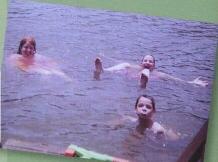 |
Home | Search | Browse | About IPO | Staff | Links |
 |
Home | Search | Browse | About IPO | Staff | Links |
|
Micro-camping
If you plan ahead and travel light, your next camping trip can be via a compact car.
STORY BY SUSAN DUKE Last July with gas prices way too high for my compressed budget and our usual campground destinations quite a distant drive, my family and I decided to experiment with our regular camping style. Instead of a truckload of gear, our great adventure was going "micro-camping." With a little planning, we packed our camping gear, loaded bicycles on the portable bike rack and hit the road to visit some of our favorite state and national parks. There were four of us— one adult and three pre-teen children— and the plan was to live out of our car for a week. Before we get too far into the story, let me pass along a few tips based on the lessons I learned.
My rules of the road for micro-camping include organization and packing the bare necessities. Count out only what you need for your trip, and leave the excess items at home. Plan to stop daily to purchase fresh food. Pack three days of clothing, and stop to do laundry during the week. Pack your cleaning supplies and cooking and eating utensils in mesh, draw-stringed bags to hang for quick drying. Perfect your packing techniques. Lay your large items flat in the bottom of the trunk to conserve space. Roll clothing tightly. Pack items within items—open space is a waste! Plan your outing to have minimal impact on the environment. Take a clothesline for drying towels, swim suits and eating utensils. Secure the line with bunge cords around trees to minimize damaging the bark.
Be prepared for emergencies. In addition to the requisite first-aid kit, pack emergency cash and travelers' checks. A spare set of keys will come
16 tdoorIllinois
in handy if yours happen to fall into the lake while fishing. In a plastic bag in the glove compartment, store emergency phone numbers, photocopies of your drivers license and credit cards, and car and health insurance information. A map is a necessity for planning your route and stops along the way. Safety equipment, such as a compass, signal mirror and whistle, will provide a little peace of mind when exploring unfamiliar parks, and a cell phone is a good idea, should an emergency arise. Each of us had a school-sized backpack for our personal items. General provisions took up most of the trunk space, and we found there is an art to loading the trunk. Here's the magic formula we finally settled on. Place sleeping pads and ground cloths in the bottom, followed by two lawn chairs. In the forward trunk area, under the rear window, pack sleeping bags and tents. Put shoes in the open spots. The rear trunk area should be reserved for things needed throughout the day, such as backpacks, fishing gear and the grill. Fill any open space with the remaining gear—canned goods, laundry items, paper goods, cooking supplies, clothesline, a lantern and so forth.
Place items such as water bottles, the camera, hand-held games, music, Walkie-Talkie radios and soft-sided zippered coolers with drinks and snacks in the car so they are easily accessible throughout the day. For those short-legged travelers, a backpack stored on the floor makes a perfect footrest. Our final task was to strap the portable bike rack on the trunk and load the bikes. In a few short minutes, we were ready to set off on our day's journey. For meals, we heated canned goods or purchased fresh items from a local grocer. We never packed into our cooler more than we could eat or drink in 24 hours. When traveling between destinations, we drove during the hottest part of the day to take advantage of the air-conditioned car. We set up camp in the late afternoon when it was cooler. In addition to our mid-week visit to a
self-service laundry, we stopped at local public libraries during the heat of the day to browse newspapers and periodicals and to use the Internet to send email to family and friends. Living out of a tent and the car trunk for a week of "micro-camping" wasn't as difficult as I thought it would be. Not a single kid complained about being bored or homesick. We saw new places nearly every day. We swam, biked, hiked, rode horses, fished and visited museums. We traveled comfortably and weren't burdened by more gear than we needed. Forgotten items were as close as the nearest town. We could have gone home at any time during our vacation, but we stayed out an entire week. It actually got easier each day. Since we would have been purchasing groceries even if we had stayed home, our only trip-related expenses were camping and sightseeing fees and fuel. For an enjoyable trip to explore some of the scenic wonders of Illinois, consider simplifying your life and setting off on your own "micro-camping" adventure.

18 OutdoorIllinois |
|
|